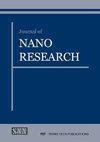Electrochemical Behavior of Nanocrystalline NiMoO4 Hydrate Modified by Ultrasound
IF 1
4区 材料科学
Q4 MATERIALS SCIENCE, MULTIDISCIPLINARY
引用次数: 0
Abstract
To improve the specific capacitance, power and energy of electrical energy storage devices, in particular hybrid capacitors, various methods of cathode material modification are used. One of the methods of modifying nanostructured materials without applying high temperatures, pressures and long reaction times is ultrasonic treatment. Although the interaction of ultrasound with the structure and surface of electrode materials is well enough studied, there are few works that investigate the optimal duration of ultrasonic treatment and its relationship with the capacitive characteristics of these materials. Therefore, we investigated the efficiency of ultrasonic dispersion of nanocrystalline nickel molybdate hydrate for 15, 60 and 90 minutes. The appearance of two cathodic peaks on cyclic voltammetry patterns was analyzed and the charge / discharge mechanism of the electrode based on nanocrystalline NiMoO4 hydrate was presented. Based on the results of potentiodynamic and galvanostatic studies the specific capacitances of the initial NiMoO4 and the material modified by ultrasound for 15, 60 and 90 minutes were calculated. The proton diffusion coefficients of nickel molybdate hydrate were determined on the basis of the Randles–Sevcik equation. NiMoO4 subjected to ultrasonic dispersion for 60 min as a cathode material in a hybrid electrochemical system was tested.超声修饰纳米晶NiMoO4水合物的电化学行为
为了提高电能存储装置,特别是混合电容器的比电容、功率和能量,采用了各种阴极材料改性的方法。在不使用高温、高压和长时间反应的情况下改性纳米结构材料的方法之一是超声波处理。虽然超声波与电极材料的结构和表面的相互作用研究得很好,但很少有研究超声波处理的最佳持续时间及其与这些材料的电容特性的关系。因此,我们研究了15、60和90分钟的超声波分散纳米晶水合钼酸镍的效率。分析了循环伏安图上两个阴极峰的出现,探讨了纳米晶水合物NiMoO4电极的充放电机理。根据动电位和恒流研究的结果,计算了初始NiMoO4和超声修饰材料在15min、60min和90min时的比容。根据Randles-Sevcik方程,确定了水合物钼酸镍的质子扩散系数。以NiMoO4为正极材料,在混合电化学体系中进行了超声分散60 min的实验研究。
本文章由计算机程序翻译,如有差异,请以英文原文为准。
求助全文
约1分钟内获得全文
求助全文
来源期刊

Journal of Nano Research
工程技术-材料科学:综合
CiteScore
2.40
自引率
5.90%
发文量
55
审稿时长
4 months
期刊介绍:
"Journal of Nano Research" (JNanoR) is a multidisciplinary journal, which publishes high quality scientific and engineering papers on all aspects of research in the area of nanoscience and nanotechnologies and wide practical application of achieved results.
"Journal of Nano Research" is one of the largest periodicals in the field of nanoscience and nanotechnologies. All papers are peer-reviewed and edited.
Authors retain the right to publish an extended and significantly updated version in another periodical.
 求助内容:
求助内容: 应助结果提醒方式:
应助结果提醒方式:


